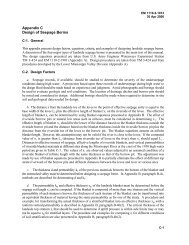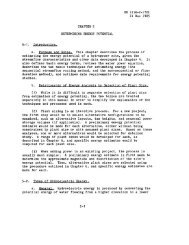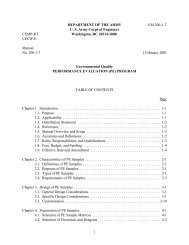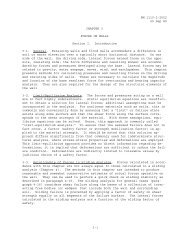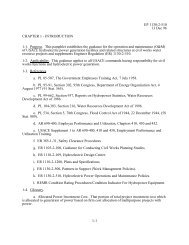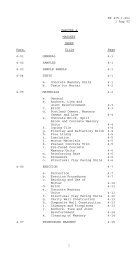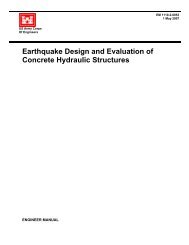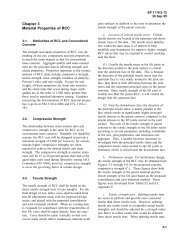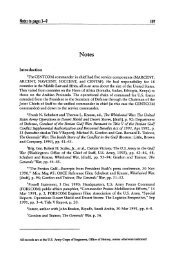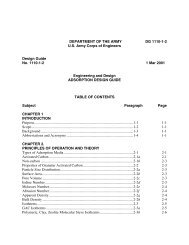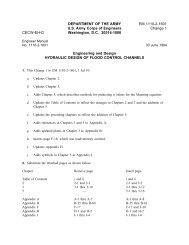em2901.chp:Corel VENTURA - Publications, US Army Corps of ...
em2901.chp:Corel VENTURA - Publications, US Army Corps of ...
em2901.chp:Corel VENTURA - Publications, US Army Corps of ...
You also want an ePaper? Increase the reach of your titles
YUMPU automatically turns print PDFs into web optimized ePapers that Google loves.
EM 1110-2-2702<br />
1 Jan 00<br />
For design analysis, load combinations and associated load factors should be applied accordingly. Various<br />
loads that are applied to the models (such as the gate reaction loads including sill load RS and the wire rope<br />
pressure load RQ/r) are not factored, since they are a function <strong>of</strong> other factored loads.<br />
(1) Skin plate assembly. For the 2-D approximate model, the skin plate and ribs are assumed to have<br />
zero curvature. The skin plate serves two functions. First, each unit width <strong>of</strong> skin plate is assumed to act<br />
as a continuous beam spanning the ribs in the horizontal direction (Figure 3-10). Second, the skin plate<br />
acts as the upstream flange <strong>of</strong> the ribs. The ribs, with the skin plate flange, are continuous vertical beams<br />
that are supported by the horizontal girders (Figure 3-11). A portion <strong>of</strong> the skin plate is considered to act<br />
as the upstream flange <strong>of</strong> the rib (paragraph 3-5.b(2)).<br />
(a) Boundary conditions. Boundary conditions consist <strong>of</strong> simple supports located at each rib for the<br />
skin plate and at each girder for the rib members.<br />
(b) Loads. Loading on the skin plate assembly consists <strong>of</strong> various combinations <strong>of</strong> factored loads and<br />
gate reaction loads. Factored loads consist <strong>of</strong> 1.2H or 1.4H, 1.2 WA, 1.0E, kII, and 1.2Q3/r, and gate<br />
reaction loads include Rs and RQ/r. H, WA, E, I, and Q3 are defined in paragraph 3-4.b, r is the gate radius,<br />
Rs is the sill reaction load at the bottom <strong>of</strong> the skin plate (load case 1 gate closed), and RQ is the wire rope<br />
reaction load (for load cases 2 and 3 for gates with a wire rope hoist). The factored loads shall be applied<br />
in accordance with paragraph 3-4.b(2). Gate reaction loads RS and RQ/r are determined by equilibrium <strong>of</strong><br />
the end frame model for each appropriate load condition (paragraph 3-5.a(3)) and are not factored since<br />
they are a function <strong>of</strong> other factored loads. For skin plate design, loads are determined based on a unit<br />
width <strong>of</strong> plate, and it is not considered necessary to include I and RS. For the rib model, the magnitude for<br />
loads is determined based on the tributary area <strong>of</strong> the rib. For each rib, the tributary portion <strong>of</strong> RS is<br />
resolved into a radial component that is applied as a concentrated load at the end <strong>of</strong> the rib cantilever, and a<br />
tangential component that is applied as an axial force. Although not applied directly, all loads described in<br />
paragraph 3-4.b can affect rib member forces, since the reaction forces at the sill or under the wire rope<br />
include the effects <strong>of</strong> trunnion friction Ft, hydraulic machinery loads Q1 and Q2, and gravity loads C, M,<br />
and D as defined in paragraph 3-4.b.<br />
(c) Results. Analysis <strong>of</strong> the skin plate model will yield the calculated stresses and out-<strong>of</strong>-plane<br />
deflections necessary to size the skin plate in accordance with paragraphs 3-4.c(1) and 3-6. Analysis <strong>of</strong> the<br />
rib model yields the calculated moments necessary for rib design in accordance with paragraph 3-4.c and<br />
reactions are the girder loading for the girder frame model.<br />
(2) Girder frame model. The 2-D analytical model is a single-story frame consisting <strong>of</strong> beam<br />
members that simulate the horizontal girder and two columns that represent the corresponding end frame<br />
struts (Figure 3-12). The strong axes <strong>of</strong> the struts are oriented to resist flexural forces in the plane <strong>of</strong> the<br />
frame. The model shown in Figure 3-12a applies for all load cases described in paragraph 3-4.b except<br />
the unsymmetric load cases 3 and 4. For these cases, the analytical model should include applied loads<br />
with an imposed lateral displacement to represent side sway <strong>of</strong> the frame (Figure 3-12b). For load case 3,<br />
the lateral displacement should be consistent with the expected displacement as determined by an<br />
appropriate analysis (paragraph 3-5.e). For load case 4, the maximum displacement (lateral displacement<br />
to the pier face) should be applied. For all load cases except load case 4, the frame is not braced against<br />
side sway and the analysis should be conducted accordingly (AISC (1994), Chapter C). For load case 4,<br />
the frame can be assumed to be braced with the maximum displacement applied.<br />
(a) Boundary conditions. The supports for the structure are at the bottom <strong>of</strong> the columns or struts and<br />
should be modeled to simulate actual conditions. Where cylindrical pins are used at the trunnion, a fixed<br />
3-22




